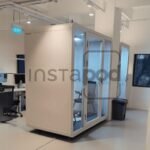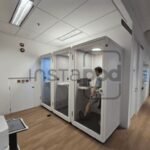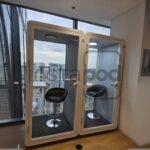No pods added to your quote request yet. Add some now for a free quote!
From Concept to Comfort: Designing the Ideal Office Pod
-1024x768.jpg)
As remote work and hybrid working models become increasingly common, the demand for private, adaptable, and comfortable workspaces has surged. Office pods have emerged as a popular solution, offering a flexible and efficient way to carve out dedicated workspaces in a variety of environments. From concept to comfort, designing the ideal office pod involves careful consideration of various factors, including functionality, aesthetics, ergonomics, and sustainability.
1. Understanding the Purpose of the Office Pod
The first step in designing an office pod is understanding its intended use. Is the pod meant for focused individual work, collaborative sessions, or video conferencing? The purpose dictates the size, layout, and features of the pod. For example, a pod designed for focused work may prioritize soundproofing and minimal distractions, while a collaborative pod might include seating arrangements that facilitate communication and brainstorming.
Additionally, considering the pod’s location is crucial. Will it be situated within an open office environment, a coworking space, or a home? The surrounding environment influences the pod’s design elements, such as the level of sound insulation, privacy features, and even aesthetic choices.
2. Prioritizing Ergonomics and Comfort
Comfort and ergonomics are paramount when designing an office pod, especially for prolonged use. The furniture within the pod should be adjustable and supportive, catering to various body types and working styles. An ergonomic chair with lumbar support, a height-adjustable desk, and a monitor at eye level can prevent strain and promote a healthier posture.
Lighting also plays a significant role in comfort. Natural light is ideal, but in its absence, adjustable, non-glaring artificial lighting that reduces eye strain should be incorporated. Consider the use of LED lights with adjustable brightness and color temperature to create a conducive working environment throughout the day.
Temperature control is another factor that can impact comfort. Pods can become stuffy and uncomfortable without proper ventilation. Installing adjustable air vents or a small, quiet fan can help maintain a comfortable temperature.
3. Incorporating Technology and Connectivity
A modern office pod must be equipped with the necessary technology to support productivity. This includes power outlets, USB ports, and wireless charging stations. High-speed internet connectivity is essential, particularly in pods designed for video conferencing or collaborative work.
For video calls, soundproofing and acoustic treatment within the pod are critical to ensuring clear audio quality. Incorporating noise-canceling technology and strategically placing acoustic panels can minimize external noise and echo.
Additionally, consider integrating smart technology to enhance the user experience. Features like automated lighting, climate control, and even virtual assistants can make the pod more functional and user-friendly.
4. Focusing on Aesthetics and Personalization
While functionality is crucial, the visual appeal of the office pod should not be overlooked. A well-designed pod can enhance the overall workspace, whether in a home office or a corporate setting. The choice of materials, colors, and finishes should align with the brand identity or the personal style of the user.
Wood, metal, and glass are popular material choices, each offering a distinct look and feel. Soft furnishings, like cushions or rugs, can add warmth and comfort to the space. The color palette should be calming and conducive to focus—think neutral tones with pops of color for vibrancy.
Personalization is also a key aspect of the ideal office pod. Allowing users to customize their space with personal items, artwork, or plants can create a more inviting and inspiring environment. Modular design elements can also enable users to adapt the pod to their changing needs over time.
5. Emphasizing Sustainability and Environmental Impact
Sustainability is becoming an increasingly important consideration in office design. Choosing eco-friendly materials, such as sustainably sourced wood or recycled metals, can reduce the environmental impact of the pod. Energy-efficient lighting, low-VOC (volatile organic compound) paints, and recyclable components further enhance the pod’s green credentials.
Moreover, the lifecycle of the pod should be considered during the design phase. Opting for durable, long-lasting materials and ensuring that the pod can be easily disassembled or repurposed at the end of its life contributes to a more sustainable product.
6. Ensuring Flexibility and Adaptability
Finally, the ideal office pod should be flexible and adaptable to different users and environments. Modular designs that allow for easy reconfiguration or expansion can accommodate evolving needs, whether in a growing business or a changing home office setup.
The pod should also be easy to install and relocate if necessary. Lightweight materials and a simple assembly process can make the pod more versatile and appealing to a wider range of users.
Conclusion
Designing the ideal office pod involves a careful balance of functionality, comfort, aesthetics, and sustainability. By focusing on ergonomic design, integrating modern technology, and considering environmental impact, designers can create office pods that not only enhance productivity but also provide a comfortable and inspiring workspace. As the way we work continues to evolve, office pods will likely become an integral part of our work environments, offering a flexible solution to the demands of modern work life.
Check these out too!
-
 Can Telephone Booth Replace a Private Office?December 5, 2025/0 Comments
Can Telephone Booth Replace a Private Office?December 5, 2025/0 Comments -
 Soundproof Pod: The Quiet Revolution in Workplace DesignDecember 5, 2025/
Soundproof Pod: The Quiet Revolution in Workplace DesignDecember 5, 2025/ -
 How Acoustic Pods Improve Collaboration & FocusDecember 5, 2025/
How Acoustic Pods Improve Collaboration & FocusDecember 5, 2025/

-e1723019914292.jpg)